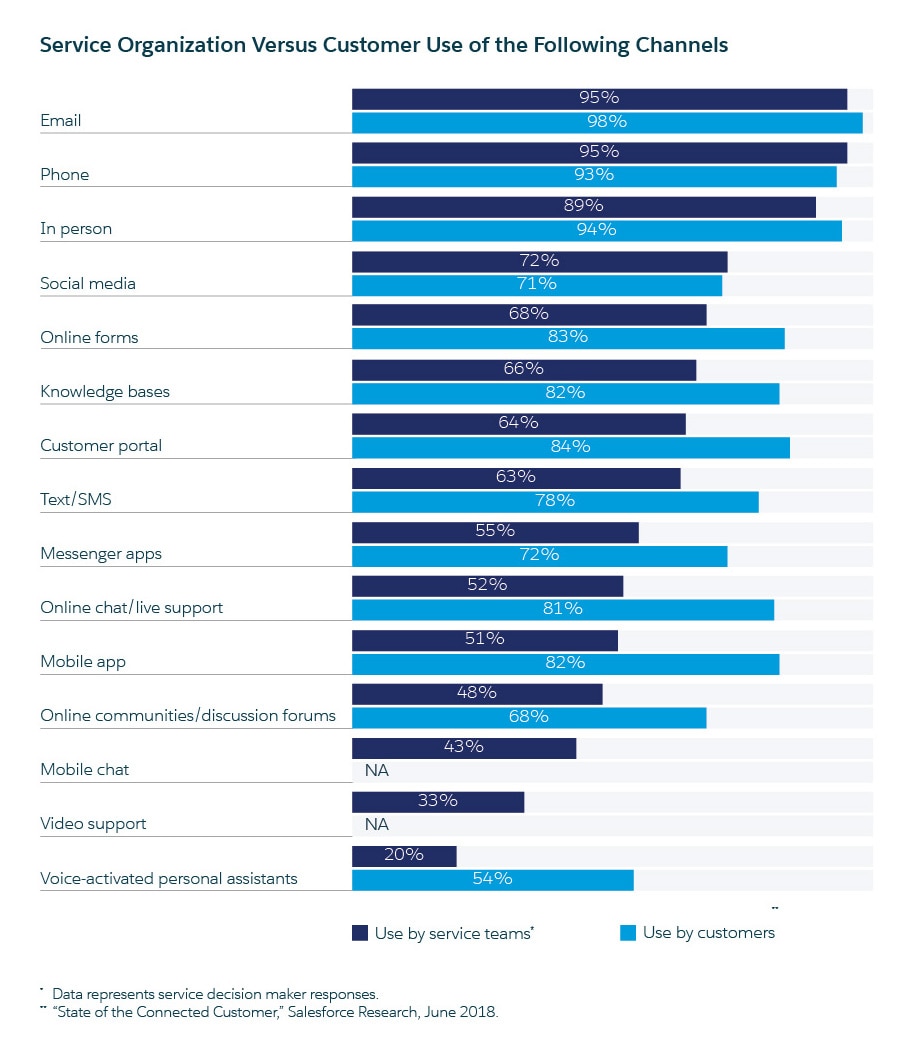You can’t help people if you can’t find them. When you’re looking to improve customer loyalty, you need to start where the customers are—meaning you reach and integrate into all the channels they use, like phone, text, live chat, email, social media, and customer portals. And reaching across all of those portals with consistency is the foundation of omnichannel support.
If you can find your customer where they are (read: in their preferred channel), then you can focus your strategy on building out customer experiences going forward. No one thought social media would explode in the manner it has, but those that jumped on that train are already far ahead of those that watched. Using more updated platforms to find your customer and serve their needs will help you stay ahead of customer support competition.
At VHT, we’re all about being where your customers are—so omnichannel is a vital tactic to create an unforgettable customer experience.
What is omnichannel support?
Omnichannel support (offering integrated support through different channels like phone, email, customer portals, and social media) is becoming more and more significant as companies and brands explore better ways to improve customer satisfaction. Over 40% of consumers complain that repeating their issue to different agents in customer support indicates bad customer service.
Even if your business already has separate phone, email, chat, and text response teams, those teams need to handle a customer’s issue at any point in their journey and pick up where another team has left off. So, for example, if a customer hits a dead end in self service, starts a chat, they should be given the option to transition—seamlessly—into the contact center. And this should all be done without repeating the original problem.
This is omnichannel (as opposed to multi-channel) support.
If you’re not offering omnichannel support, you may be missing large swathes of your customer base. In 2019, there was a 287% higher purchase rate when marketers used three or more channels in any one campaign as opposed to those using just a single channel. With businesses focusing on omnichannel marketing to increase revenue, customer service needs to focus on omnichannel support for greater customer satisfaction and a wholistic customer experience.
Quick tip: Transitioning into the contact center is often the number one way context gets lost. Mindful makes cross-channel transitions smoother by carrying context over from digital assets through to a live agent.
Omnichannel support makes customers feel appreciated.
Reaching out to a customer makes them feel noticed. And, the more they’re acknowledged, the more a customer will develop a sense of loyalty to your brand. Sixty-eight percent of consumers say it increases their perception of a brand when companies send them proactive customer service notifications. If a customer starts their experience by heading for your knowledge base first, using automation to reach out to them in another channel will guarantee they feel seen.
Source: Salesforce
This chart shows how customers’ preferred channels fare against service organization’s usage of the same channels. In almost every aspect (except phone and social media), customers are ahead of the game. Service organizations and customer experience teams need to catch up. Quickly.
Immediate omnichannel support responses show empathy.
The speed and immediacy of your response goes a long way in helping foster customer loyalty. Ninety percent of customers rate an “immediate” response as essential to customer loyalty when they have a support issue, and 60% of customers define “immediate” as 10 minutes or less.
Callers that choose a callback are willing to tolerate 300% as much wait time as callers waiting in queue—while still remaining brand promoters. This is helpful when immediacy isn’t an option, providing ways for customers to control their experience. Then you can follow up with immediate messages to confirm their place in line and a path to resolution.
When you stub a toe in the middle of the night, and your partner asks with concern, “Are you all right?” you get a sense of love and comfort. But if you stub your toe and three days later your partner asks over breakfast, “Did you stub your toe the other night?” you get less of a sense of comfort and more a feeling of disappointment. This is immediacy versus passive concern. It’s possibly damaging in a relationship—but it’s lethal in customer support.
Reaching out in itself should not be the only thing your CX (customer experience) teams should focus on. When they reach out is also important. Twelve percent of customers report lack of speed as a big qualifier in determining poor customer support, and 80% of American consumers say that speed (in conjunction with knowledgeable help and friendly service) determines a positive customer experience.
And it’s not just response times that build customer loyalty. Actually solving their problem is essential—and doing it right the first time is a good practice if you want your customers to stay with you in the long run. Sixty-seven percent of customer churn is preventable if the customer issue was resolved at the first engagement. Twenty-nine percent of consumers ranked first contact resolution as most valued in customer service and support interaction. Together, these stats show that getting to your customer quickly and solving their issue immediately is a great driver of customer satisfaction.
Another statistic to consider: 63% of Mindful callers have a first-time resolution, achieved mainly by carrying over context from digital channels, providing the agent with the right info.
But where are your customers looking for that support?
What are your customers’ preferred channels?
Phone
It’s a common misconception that only an older demographic uses the phone to complain or raise questions to a company or brand. That may come from the fact that when we say phone support, our mind conjures up an image of an older person yelling through a landline trying to get the answer to a problem.
But customers want to use the phone. Seventy-five percent of consumers will still choose to interact with a real person even as the technology for automated solutions improves. People who take the time to call are people who need a personal touch, a human interaction. Meanwhile, if someone calls you looking for an answer or resolution of a problem, and they have to wait more than 10 minutes for a response, you are doing irreparable damage to your product or service.
You may also want to segment customers by CLV (customer lifetime value) to ensure top customers are getting VIP treatment.
Compare that to email support, where people typically are expecting a delay in responses. Most consumers expect an email response within an hour. If someone emails you a support question and you respond within minutes, you’re definitely cultivating customer loyalty with your consumer base.
Email brings the cost of customer-employee interaction down because an email response is a-synchronous, which gives an agent the ability to respond to more problems in a shorter time. In contrast, a phone call is continuous.
Due to this, the scalability of email support is much greater than phone support. Because 96% of customers expect a response within 48 hours, there’s a lot more time to research the right answer. It doesn’t have the immediacy of a phone call—nobody likes to hear, “Let me put you on hold while I look that information up.”
But the main problem with email is that it is far less personal than a voice conversation. If the language feels canned and generic, customers may feel less valued, and the downward spiral starts. Also, getting the point across in email (especially when explaining difficult or complicated steps) can be tough.
Text
With more than 6 billion smartphones out there, texting has become a very viable option for customer interaction. Mobile commerce (coined mCommerce) will be responsible for nearly 73% of sales, or roughly $3.56 trillion, in 2021. With so many people shopping from their phones, it is expected that many will contact customer service via their mobile devices. Additionally, 89% of consumers report they want to communicate with brands using text messages.
Text is even faster than email and can be personalized as effectively as a phone call. People are programmed to read texts immediately, regardless of who the text is coming from. Sixty-eight percent of people say checking, sending, and answering text messages is the activity they do most on their phones, and 82% of consumers say they open every text message they receive. It’s also private. No one has to hear about the difficulty you’re having with a company while you’re standing in line at the bank.
So with the immediacy of texting, what’s stopping your CX team from supporting customers on this channel? The barrier is usually implementation. Starting a new texting support feature may seem daunting, but a good SaaS (software as a service) company can help with setting up a text response option.
Social media
It may be hard for many to remember what life was like before social media. It’s pervasive:3.8 billion people are active social media users, with Facebook accounting for 2.74 billion of those users. What does this mean for omnichannel teams? Ninety-five percent of adults between the ages of 18 and 34 are likely to follow a brand through social media channels. Responding to dissatisfied customers through social media outlets is now an expected reaction, not an exception. Also, the more creative you get about connecting with customers through social media, the greater your return.
Because of the immediacy of social media, it’s important to pay close attention to your brand’s social media channels and respond as quickly as possible to any interactions, positive or negative, to help improve customer loyalty. Going “viral” can be good or bad, but it can have a lasting effect on a brand or business when it’s bad.
Remember that when dealing with omnichannel support, you need to offer every option available to help the customer. Even with social media, make sure to follow up with resolution through any other available channel. When doing so, it’s extremely helpful to let the customer schedule their conversation on their time, which will lead to higher NPS scores and a more predictable call volume (which will help lower cost by allowing you to manage call center headcount). This will also allow them to state their needs when scheduling, so the agent has the issue before them, the call could be resolved faster, and most importantly, the customer feels validated and seen.
Live chat and chatbots
Live chat is the midpoint between text and phone channels. It offers the immediacy of text and the humanity of a phone conversation.
Live chat is highly effective in certain demographics because the response is immediate. Customers will also use it as fact-finding without a hard-sell because they can disconnect at any time. For instance, you can ask a bunch of questions about your insurance coverage without committing to buying anything. Try doing that in a car dealership.
Remember, it’s a chat: Show some empathy for your customer as you would in a face-to-face conversation, make sure to make them feel at ease, and always work together toward a resolution. Also, customer service reps need to avoid being overloaded with too much information—people love to be heard. Reps should make sure to restate to the customer what they believe the issue to be.
And when chat isn’t cutting it? Offer a seamless transition into voice, giving the customer the ability to schedule a call with an agent, and carry the chat context through to the call for a surprisingly pleasant customer experience.
Customer portals and knowledge bases
A customer portal is simply where the customer enters into their support experience with you. A knowledge base is usually an FAQ or archive of previously answered customer service questions. Customers (and executives with web-based self-service support systems) prefer knowledge bases over all other self-service channels. That’s because a knowledge base is less reliant on interaction. If a customer can find the resolution to a problem easily through a knowledge base, they walk away with a sense of winning something.
According to a report by Vanilla, 91% of their survey respondents said they would use a knowledge base for self-service support if it were available. The issue is, of course, the relevancy and ease of use of the portal or knowledge base. If your knowledge base is not updated frequently or contains misleading or unhelpful information, the customer will reach a dead end and seek other support. Although there’s a higher risk in relying on knowledge bases exclusively, the reward is that more people will resolve their problems or questions. Unfortunately, many customers will leave after just one try—and you don’t want that.
Use a service to integrate your CX platforms.
You can also improve customer loyalty in your customer’s preferred channel by using a service to integrate your multi-channel efforts into a concerted omnichannel strategy. Services like VHT’s Mindful platform can take away the worry and give you back the hurry so that you can reach more customers in a shorter amount of time with a full suite of options like:
Digital Callback: Customer-centric call scheduling that manages customer contacts on the voice channel. It “holds your place in line” by virtual queueing the customer and notifying them when an agent is available so they have more time on their hands—not spent waiting on hold.
Messaging: Using their Mindful platform, clients automatically have the option to include text messaging services. Use two-way communication to build brand affinity and customer loyalty.
Analytics: VHT returns actionable data about how Mindful is being applied to call center activities and customer experience metrics.
Notifications: Mindful features an entire suite of automated text message notifications developed to reduce call volume and increase customer satisfaction and customer loyalty.
Summing up
Outreach via your customer’s preferred channel is proactive, personal, and highly effective.
If you want to foster greater customer loyalty, don’t make a customer find you. Find them, and use the communication channels they use, including phone, text, social media, chat, and email. Omnichannel support data shows that 85% of teams reported having to make changes to their support in 2020 because of the need to increase customer support across different channels.






